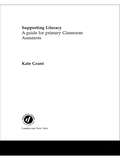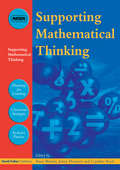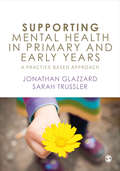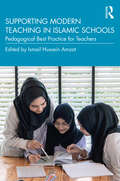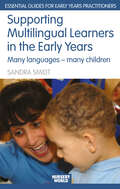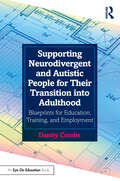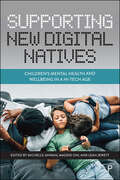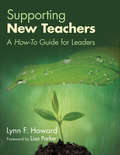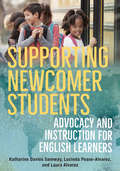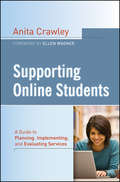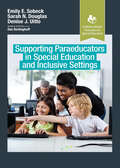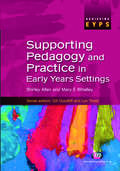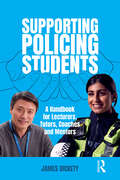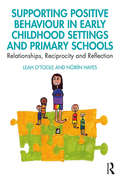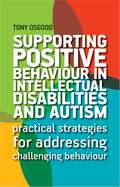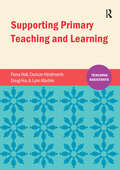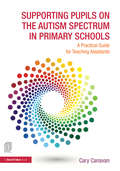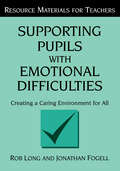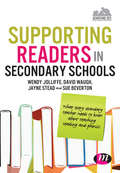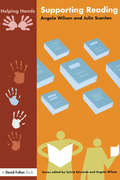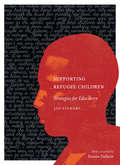- Table View
- List View
Supporting Literacy: A Guide for Primary Classroom Assistants
by Kate GrantClassroom assistants are increasingly relied upon to support the most needy pupils, and they have had significantly less training than their colleagues with qualified teacher status. It is clear that these assistants need some very practical materials. This book provides photocopiable resources so that classroom assistants can get to work.The book covers all they need to know about literacy, it explains in very simple terms what is expected from them and:*how the National Literacy Strategy works*how to support reading, writing and spelling*how to select fiction and non-fiction*how to help children use computersIt also covers issues such as:*how to help children for whom English is not their first language*how to help children with special needs*how to set targets and monitor progress.As well as providing an invaluable manual for assistants, Supporting Literacy will be useful for SENCOs and English Co-ordinators who are training support staff and volunteers in primary schools. Learning Support Assistants and others following recognised courses (eg Specialist Teacher's Assistants) will find the book helpful in the study of children's literacy.
Supporting Mathematical Thinking (nasen spotlight)
by Anne Watson Caroline Roaf Jenny HoussartTo what extent do curriculum subjects, particularly highly abstract ones such as Mathematics, have their own unique special needs? This book celebrates the work done by subject specialists in mainstream classrooms to promote inclusive practice. It describes new and creative ways of developing mathematical thinking among pupils. Each chapter demonstrates reflective minds at work, close observation of learners, willingness to understand the students’ thinking process and patient commitment to students over long periods of time. Features of the book include: how low-attaining students can think mathematically numeracy recovery task refusal in primary mathematics progression in written calculation strategies for division using graphic calculators with low-attaining pupils generalising arithmetic: an alternative to algebra learning support assistants in mathematics lessons inclusion and entitlement, equality of opportunity and quality of curriculum provision.
Supporting Mental Health in Primary and Early Years: A Practice-Based Approach
by Jonathan Glazzard Sarah TrusslerEmphasising not just mental health needs, but also the importance of creating a culture of inclusion for all pupils so that all pupils develop high self-esteem, emotional intelligence, social confidence and resilience, this book provides: an introduction to key theories that relate to mental health; an overview of the current context in relation to mental health in schools; guidance on the identification of pupils with mental health needs; evidence-based research on interventions to support pupils with mental health needs; an assessment tool which will support teachers in identifying needs and planning subsequent interventions; case studies of practice from a primary school and early years setting. Based on action research which has been implemented in a primary school, this important text is valuable reading for students on teacher training courses, and practising primary school teachers.
Supporting Mental Health in Primary and Early Years: A Practice-Based Approach
by Jonathan Glazzard Sarah TrusslerEmphasising not just mental health needs, but also the importance of creating a culture of inclusion for all pupils so that all pupils develop high self-esteem, emotional intelligence, social confidence and resilience, this book provides: an introduction to key theories that relate to mental health; an overview of the current context in relation to mental health in schools; guidance on the identification of pupils with mental health needs; evidence-based research on interventions to support pupils with mental health needs; an assessment tool which will support teachers in identifying needs and planning subsequent interventions; case studies of practice from a primary school and early years setting. Based on action research which has been implemented in a primary school, this important text is valuable reading for students on teacher training courses, and practising primary school teachers.
Supporting Modern Teaching in Islamic Schools: Pedagogical Best Practice for Teachers
by Ismail Hussein AmzatSupporting Modern Teaching in Islamic Schools: Pedagogical Best Practice for Teachers advocates the revamp of the madrasah system and a review of the Islamic curriculum across Muslim countries and emphasises training needs for Islamic teachers for modern instructional practice. Islamic schools across Muslim countries face 21st-century challenges and teachers need continuing professional development to help them keep abreast of modern teaching practice. Books, papers, educators and parents have consistently called for curriculum change to transform teaching and learning in Islamic schools. Divided into three unique parts, Part 1 of the volume focusses on content knowledge, pedagogy and teaching methods; Part 2 highlights professional development, responsibilities and lifelong learning; and Part 3 comprises chapters on Islamic curriculum review, reform and Islamisation of knowledge. Scholars from the United States, United Kingdom, Europe, Canada, Australia, New Zealand, Asia and Africa review the Islamic curriculum to highlight areas for further improvement and provide modern techniques and methods of teaching for pedagogical best practices and effective outcomes in Islamic schools. With these contributions, this volume will be of interest to OIC countries, Islamic student teachers and Islamic teachers who work in international and local settings.
Supporting Multilingual Learners in the Early Years: Many Languages - Many Children (Essential Guides for Early Years Practitioners)
by Sandra SmidtShortlisted for the Nasen Book that supports SEN and Disability Issues Award 2008 Are children who are exposed to more than one language from birth at an advantage or a disadvantage when starting school? Supporting Multilingual Learners in the Early Years examines the theoretical, ideological and practical issues involved in the education of children speaking two or more languages coming to settings which are predominantly monolingual. The book examines current research and thinking about the advantages and disadvantages of being multilingual and tackles complex topics such as: what being multilingual implies in terms of prior learning and why this matters in education the importance of respect for diversity and encouraging children to be proud of their language and culture practical ways to help young children acquire English ways of working with parents who themselves have little or no English the differences and difficulties involved in a child learning an additional language so early on in their lives strategies for exploring the learning of multilingual learners and a review of the resources and activities that could help. Sandra Smidt views multilingualism as a cognitive advantage and shows how Early Years practitioners can use interactive styles of learning to focus on the benefit that the many cultures and languages in the classroom can bring to children’s learning and development. Written in a highly accessible tone, this book offers practitioners a mix of practical case studies and examples in which theory is embedded and its importance explained. Students of early childhood education will also appreciate the author's carefully structured approach to the topic, as she includes summary boxes, glossaries and points for reflection in each chapter.
Supporting Multilingual Learners’ Academic Language Development: A Language-Based Approach to Content Instruction
by Luciana C. de OliveiraA practical and comprehensive resource, Supporting Multilingual Learners’ Academic Language Development: A Language-Based Approach to Content Instruction introduces an accessible language-based approach to teaching academic language to multilingual learners across the content areas. Luciana C. de Oliveira provides elementary school teachers with everything they need to know to successfully teach grade-level content to multilingual learners. Chapters are organized by subject, addressing the specific language demands of teaching English language arts, social studies, mathematics, and science. Each chapter features examples of implementation in grades K-5, practical strategies, and a wealth of tables, figures, and other resources. The Language-Based Approach to Content Instruction (LACI) in this book provides teachers with a ready-to-use framework of six scaffolding elements that serves as a guide to enable multilingual learners to meet the grade-level standard of their peers without simplification. Aligned with WIDA and CCSS standards, this resource provides the tools and methods teachers need to support multilingual learners’ academic language development in the content area classroom.
Supporting Neurodivergent and Autistic People for Their Transition into Adulthood: Blueprints for Education, Training, and Employment
by Danny CombsThis trailblazing resource teaches educators how to support the strengths of children and teens on the autism spectrum as they transition into their lives as adults. Offering ideas and solutions to counter the currently steep unemployment rate for those on the autism spectrum in the United States, each chapter takes a strength- and asset-based approach to autism and neurodivergent education, training, and employment. The author draws upon his lived experience as a parent to a neurodivergent child to provide unique and proven strategies with real-life applications. Secondary and post-secondary educators can learn to refresh their current standards of practice and the concept of what is possible and appropriate in working with students on the autism spectrum.
Supporting New Digital Natives: Children’s Mental Health and Wellbeing in a Hi-Tech Age
by Michelle Jayman, Maddie Ohl and Leah JewettHow can we support children’s and young people’s mental wellbeing in a digital age? Through a series of informative and thought-provoking case studies, this book explores how to enable children and young people to stay safe, happy and mentally healthy at a time when so much of their lives are spent online. Featuring contributions from across research and practice, with the voice of the child at its heart, the book offers simple, practical guidance for improving wellbeing based on real-world evidence. It will be essential reading for parents, carers and professionals working with children across a range of school and community settings.
Supporting New Teachers: A How-To Guide for Leaders
by Dr Lynn F. HowardHow are you keeping new teachers? Fifty percent of new teachers leave within the first five years. Why? Exiting teachers say lack of support from the administration, specifically the principal,– causes them to quit. If leadership makes the difference in keeping new talent, get this guide to stop the new teacher exodus. Learn what to do and how to do it through a realistic look at: Stories From the Field -- features common challenges and practical strategies Administrator’s Role -- frames solutions within job function, current trends, and research-based practices Self-Reflection -- guides action planning with checklists and worksheets
Supporting New Teachers: A How-To Guide for Leaders
by Dr Lynn F. HowardHow are you keeping new teachers? Fifty percent of new teachers leave within the first five years. Why? Exiting teachers say lack of support from the administration, specifically the principal,– causes them to quit. If leadership makes the difference in keeping new talent, get this guide to stop the new teacher exodus. Learn what to do and how to do it through a realistic look at: Stories From the Field -- features common challenges and practical strategies Administrator’s Role -- frames solutions within job function, current trends, and research-based practices Self-Reflection -- guides action planning with checklists and worksheets
Supporting Newcomer Students: Advocacy And Instruction For English Learners
by Lucinda Pease-Alvarez Katharine Davies Samway Laura AlvarezCopublished with TESOL Press Newcomers need to draw on all their resources—intellectual, linguistic, cultural—as they make sense of new content and a new language. In this much-needed book, the authors marshal research and several decades of their own experience to provide instructional practices and activities that will help teachers develop newcomers as readers and writers of English and engage them in content learning across the curriculum. Equally important, they show how teachers can advocate for these vulnerable students, many of whom have experienced multiple challenges in their home countries or in the United States, including poverty, violence, and political persecution. With chapters on assessment and second-language acquisition as well as reading, writing, speaking, and content learning, their book is a timely and comprehensive guide for any K–8 educator whose classroom or school includes newcomer students.
Supporting Numeracy: A Handbook for those who Assist in Early Years Settings
by Rita HeadingtonFirst Published in 2001. Routledge is an imprint of Taylor & Francis, an informa company.
Supporting Online Students
by Anita CrawleySupporting Online Students shows how effective and efficiently delivered support services improve academic success and course retention for online learners. Drawing on a decade's worth of research, Crawley describes the scope of services that should be made available to online students, from admissions and registration to advising and student engagement. The book includes guidelines and standards for these services as outlined by half a dozen national professional organizations, as well as planning and implementation, innovative practices, and specialized services needed by particular online student groups.
Supporting Paraeducators in Special Education and Inclusive Settings (Evidence-Based Instruction in Special Education)
by Sarah Douglas Emily Sobeck Denise UittoSupporting Paraeducators in Special Education and Inclusive Settings provides an in-depth look at the role of pre- and in-service teachers as supervisors of paraeducators within special education and inclusive settings.The latest entry within the Evidence-Based Instruction in Special Education series, Supporting Paraeducators in Special Education and Inclusive Settings serves as an instructional tool for pre-service teachers and educators within higher education coursework, as well as a resource for in-service teachers. This text supports teachers in strengthening their knowledge and supervisory skills necessary to supervise and manage paraeducators in educational environments.Through objectives, scenarios, content, and chapter questions, Drs. Sobeck, Douglas, and Uitto provide a thorough and applicable overview of working with and supervising paraeducators. In this text the roles and responsibilities of paraeducators, teachers, and school administrators relative to paraeducator training and supervision will be detailed, as well as tips for collaboration.Included with the text are online supplemental materials for faculty use. School leaders and higher education faculty can use the online site for materials to support pre-service training within teacher preparation programs and professional development for in-service teachers.Supporting Paraeducators in Special Education and Inclusive Settings fills an important need in the field and is a vital resource for current and future teachers when working with paraeducators.
Supporting Pedagogy and Practice in Early Years Settings (Achieving EYPS Series)
by Mary E. Whalley Shirley F. AllenTo achieve EYPS, candidates must understand the Early Years Foundation stage (EYFS), and how to put it into practice. This text supports those on all EYPS pathways to extend their knowledge and understanding of effective pedagogy within the context of the EYFS. It begins by looking at effective practice in the EYFS and how research has informed recent initiatives. It goes on to cover children's learning and development, safe and stimulating environments and the role of the adult. The text considers how EYPs can support others in their practice to improve the delivery of learning throughout their setting.
Supporting Policing Students: A Handbook for Lecturers, Tutors, Coaches and Mentors
by James DicketyThis is an invaluable guide for those involved in supporting policing students, including lecturers, tutors, trainers, mentors and coaches. It integrates quality research and practice to help anyone in these roles provide optimal support and guidance to their policing students. Shaping the next generation of policing officers and staff comes with a unique set of challenges, so chapters cover a myriad of useful subjects related to coaching models and theories and how to apply these in a policing context. Additionally, you will find insightful teaching tips, including effective feedback strategies and guidance on addressing challenging topics like domestic abuse and courtroom appearances. Accessibly written, this book can be explored from start to finish or used as a reference guide, and includes reflective exercises and real-life policing examples to help you apply theory to practice, creating an enriching learning experience for both you and your students.
Supporting Positive Behaviour in Early Childhood Settings and Primary Schools: Relationships, Reciprocity and Reflection
by Nóirín Hayes Leah O'TooleSharing insights of various theoretical perspectives to help understand the complex root causes of children’s behaviour, Supporting Positive Behaviour in Early Childhood Settings and Primary Schools highlights key responses that can encourage positive mental health, resilience and behaviour. Drawing on a range of theoretical frameworks, this book: Translates theoretical insights into adaptable and practical responses Considers children's strengths and needs with regards to resilience and mental health Includes case studies, tasks and questions for reflection Identifies innovative practical strategies for supporting positive behaviour in educational settings Combining theoretical perspectives on supporting positive behaviour, Supporting Positive Behaviour in Early Childhood Settings and Primary Schools is user-friendly and conceptually unified. It gives early childhood and primary students and teachers a clear understanding of what to do to facilitate positive behaviour and why to do it, encouraging true professionalism in education, and ensuring children learn and develop to their highest potential.
Supporting Positive Behaviour in Intellectual Disabilities and Autism: Practical Strategies for Addressing Challenging Behaviour
by Tony OsgoodThis highly practical book is an accessible and grounded handbook for addressing challenging behaviour in children and adults with intellectual or developmental disabilities (IDD), including autism. It recognises that challenging behaviour does not appear out of nowhere and is meaningful for the person exhibiting it. Behaviour can be communicative and an important signifier of underlying sensory or environmental issues. Focusing on a person-centred approach throughout, the book has advice and strategies for working with the client's families, support staff and professionals. It also presents best practice for analysing and addressing challenging behaviour in various settings such as schools, hospitals and the home, all while stressing the need to keep the human story at the heart of any assessment and intervention. Each chapter features questions for discussion or reflection and exercises for the reader to complete. Informal, frank and free of jargon, this is indispensable for professionals, parents, and anyone working with people with intellectual disability or autism.
Supporting Primary Teaching and Learning (Teaching Assistants)
by Duncan Hindmarch Lynn Machin Fiona Hall Douglas HoyThe book is aimed at all those studying on Foundation Degrees in supporting primary and early years teaching and learning, and particularly those working at levels 4 and 5. It is written in an accessible style with a focus on work-based professional development and encourages critical reflection throughout. It starts with a discussion of reflective practice, and includes helpful guidance on developing effective study skills. Each chapter then focuses on a key topic in education, learning and development, considers any relevant policies and legislation, examines educational theories in relation to professional practice and provides concise case studies to contextualise the learning. It provides up-to-date and relevant material on supporting the new national curriculum, safeguarding, SEN and inclusion issues, and schools as organisations. It also covers the competencies for Higher Level Teaching Assistants.
Supporting Pupils on the Autism Spectrum in Primary Schools: A Practical Guide for Teaching Assistants
by Carolyn CanavanWritten to meet the needs of teaching assistants and learning support assistants, this book provides a practical toolkit for supporting students on the autistic spectrum in mainstream primary schools. The book offers a clear, jargon free explanation of autism spectrum conditions and examines the difficulties arising from these conditions and how they can impact on students’ learning. Addressing issues which arise on a daily basis, it is full of practical advice and strategies for supporting students socially and academically across all areas of the curriculum. Features include: • advice on supporting students through examinations • examples and case studies to illustrate how the strategies described work in practice • forms to help with information collection and evaluation • templates to scaffold students’ comprehension and learning in different subject areas Packed with photocopiable resources that can be adapted to suit individual students’ needs, this book is essential reading for teaching assistants that want to help their students’ on the autism spectrum to reach their full potential.
Supporting Pupils with Emotional Difficulties: Creating a Caring Environment for All (Resource Materials For Teachers Ser.)
by Rob Long Jonathan FogellFirst Published in 1999. Routledge is an imprint of Taylor & Francis, an informa company.
Supporting Readers in Secondary Schools: What every secondary teacher needs to know about teaching reading and phonics (Achieving QTS Series)
by David Waugh Wendy Jolliffe Sue Beverton Jayne SteadAre you a secondary school teacher who needs to know about phonics and teaching reading? Then this book is for you. There are lots of books on teaching phonics but most are written to support primary teachers. This book is written specifically for secondary teachers working with children who need support with reading. The text uses case studies from secondary schools to highlight effective ways to support children with reading and includes useful tips on teaching strategies and ideas for resources. The text covers the subject knowledge you need for the teaching of reading in the broadest sense, including phonics. Intended to support you, as a secondary teacher, it gives guidance on planning methods of assessment and explores a range of intervention programmes and resources. This text is your comprehensive support resource in teaching reading.
Supporting Reading (Helping Hands)
by Angela Wilson Julie ScanlonWilson and Scanlon focus on enhancing the reading skills of the pupils whom you support, analyzing how you can develop their skills, offering advise and guidance on a variety of learning styles and a breakdown of reading principles.
Supporting Refugee Children: Strategies for Educators
by Jan StewartThe psychosocial needs of war-affected children who migrate to other countries are difficult to identify, complicated to understand, and even more troubling to address. Supporting Refugee Children provides a holistic exploration of these challenges and offers practical advice for teachers, social workers, and counsellors, as well as suggestions for policy makers.
